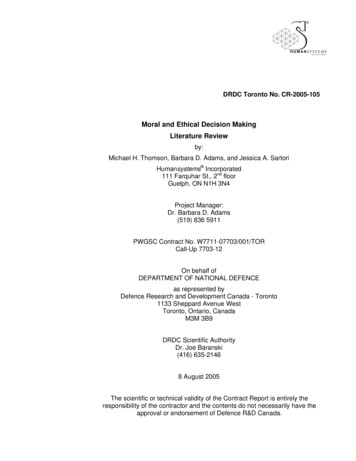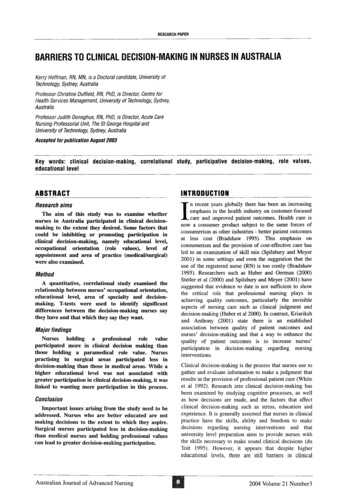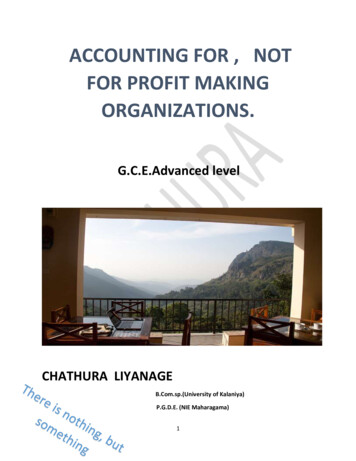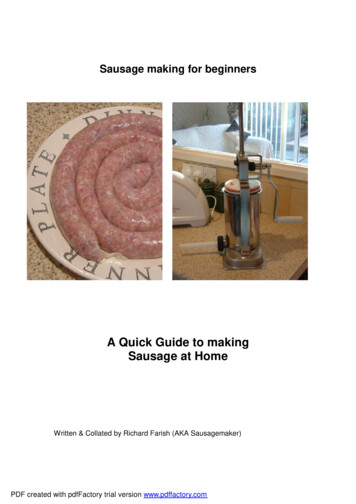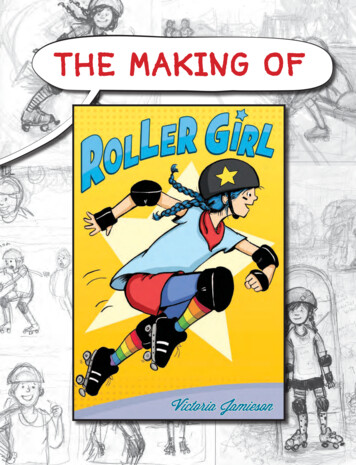
Transcription
The M ak i ng of
Hello! I’m Victoria Jamieson, author andillustrator of the graphic novel ROLLER GIRL.I wanted to make this booklet for teachers,librarians, parents, and most of all, readers, toexplain how I created ROLLER GIRL. I hopethis makes the graphic novel-making process alittle more transparent. and perhaps inspiresyou to create comics of your own.Happy reading, writing and drawing!
How I Writ e My S t ori esROLLER GIRL is my first graphic novel, but I have writtenand illustrated several picture books for younger readers.Although these books are for different audiences, they allgot their start the same way- from a subject matter I love.I first got the idea for my picture book OLYMPIG!, forexample, because I adore watching the Olympics on T.V.Ask my husband—I barely leave thecouch during those weeks. Once I havethe germ of an idea (like the Olympics),I often use experiences in my own lifeto flesh out the story. In the case ofOLYMPIG!, I drew upon my crushingdefeat in the 1984 Block Party KidOlympics to write about an athlete wholoses in every event.That’s me on thebottom right, in thegymnastics leotard.I am trying to put ona brave face, despitemy staggering lossin the gold medalround.
(IMe at Fresh Meat tryoutse).didn’t make it my first timI moved to Portland,Oregonin2009,and after finding anapartment, the nextitem on my to-do listwas to join the RoseCity Rollers. I workedmy way up fromrecreational skater, toFresh Meat, to a teamskater- and eventuallyto a travel team skater.Jamming for my home team, theBreak Neck Betties.Photo credit: Lisa Burke Photographyite BurnPhoto credit: MasonROLLER GIRL started in much the same way- from mylove of roller derby. I first learned about the sport in 2008,and I watched a home team bout of the Gotham Girls, NewYork’s roller derby league. I was hooked, and I knew I wantedto play. I started taking skating lessons and practiced,practiced, practiced.
I knew I wanted to write a story about roller derby, but apicture book didn’t feel right since the subject matter wasslightly older. A graphic novel seemed ideal as it wouldstill allow me to draw and write to tell the story. At thetime, Portland’s junior roller derby team was starting togrow, and other junior leagues were (and still are!) poppingup around the world. Junior derby plus a graphic novelseemed like a perfect fit.I was a little worried about writing and illustrating a graphicnovel. After all, I had never written one before. I wasn’ta huge fan of comic books growing up, either. but I didlove the comics in the Sunday paper. My very favorite wasa strip called For Better or For Worse, by Lynn Johnston,which chronicled the day-to-day events of a family. I wasroughly the same age as Elizabeth, and the characters cameto feel like real people to me. My mom and I would chaton the phone about them as if they were our next-doorneighbors.
I wanted my graphic novel to have thesame focus on friendship, family, andcharacter as For Better or For Worse.I decided the best way to practice fora big graphic novel would be to dosome smaller weekly comic strips. So,I started making some comics aboutmy experiences as a skater with RoseCity Rollers. It was a great way toexperiment with the medium, and wasalso a good reminder that my personalexperiences could be a jumping-offpoint for a work of fiction. You canread these comics on my website:www.VictoriaJamieson.com.After a few months of these derby comics, I felt ready tostart thinking about a graphic novel. My first step was todevelop the characters.A comic about my disastrous first Fresh Meat tryouts.
C r e ating T h e Ch aractersAstridI knew the herione of the storywould be about 12 years old,and that she would have a fieryindependent streak. But thatwas about all I knew abouther! I had a lot of work to do inorder to create a character whowould seem real to readers.When I’m trying to developnew characters, my first stepis to make lots and lots ofsketches of them. This allowsme to get to know what theylook like, of course. but moreimportantly, it allows me thetime to daydream about theirpersonalities.As I was getting to knowAstrid through drawing, I alsostarted writing down littletidbits: things she might say,situations she might findfunny, trouble she might get
into. I started thinking about the people around her: herfamily, her friends, her teammates. Slowly, all of thesesketches and words began to stitch themselves into a story.Sometimes I’ll add stories or experiences from my life toa book. I think our life experiences, however unique, oftenhave universal feelings behind them and can be great fodderfor stories. They can add a sense of honesty and realism toa work of fiction. While Astrid is not exactly like me, thereare parts of me in her. The story about touching the deadsquirrel on the playground, for example. true. (Except Ididn’t tell anyone my fears, and spent a few days terrifiedthat I had contracted rabies).
NicoleThe character Nicoleis another exampleof using experiencesfrom my life inwriting this book.Nicole is basedlargely upon mybest friend growingup, named. Nicole.(Sometimes I amNicole’s on the left, I’m on the rignot terribly creativeht.with names). Wemet in first grade, and we were thick astheives all the way through elementary school.When my family moved from Pennsylvania to Floridawhen I was twelve, we wrote letters back and forth andhad hour-long phone conversations. As middle school,and eventually high school, went on, however, it becameharder and harder to maintain those close ties when wehad different friends, different schools. different lives. Iremember feeling very sad about our slipping friendship,and also feeling helpless to do anything about it. It wasa real “growing up” experience for me, and I wanted tocapture a bit of that sadness in ROLLER GIRL.
This story has a happyending, however! Nicoleand I reconnected asadults- she was evena bridesmaid in mywedding! So even friendswho drift apart have thechance to come togetheragain.Zoey, Rachel.and othercharactersThe secondary characters are mostly comNicole and me on a verybinations of people Icomfy bench.knew growing up, andkids or grownups Iknow now. Coachingwas a great way for me to meet lots of different kids.I coached both an after-school running program calledGirls on the Run, as well as our junior derby trainingprogram, the Seedlings (which feeds into the Rosebuds,the real name of the junior program). Many of the girlsI met through these programs provided great inspiration for Astrid, Nicole, Zoey. and mean Rachel!
Photo credit: Your Sunday BestFun Fact: one of the most fun parts of writing ROLLERGIRL was picking the derby names for all of the characters.Heidi Go Seek, for example, is a skater with Rose CityRollers. For Astrid’s teammates, I wanted to use realjunior derby skater names, so I reached out to leagues inCanada, England, Australia, Sweden, and all across theUnited States, and asked skaters if I could borrow theirnames. So, all of Astrid’s teammates have real derby namesfrom junior skaters around the world! You can learn moreabout junior skaters around the world in the “Real-LifeInspiration” section at the end of this e-book.arSYog NabiaRo a rsick T e s sohThese—and many other—real skaters appear in the book.
Creating a Graphic NovelNow I’m going to get into the nitty-gritty of actually creatinga graphic novel. My first step was to draw a few samplepages to send to my editor, to make sure the size and thegeneral layout looked alright. My first draft was in blackand white, but my publisher decided they wanted the bookin color—yay! I had been hoping for color.The first version of ROLLER GIRL sent to my publisher.
The first few chapters looked good,but then came the hard part. I hadto write the rest of the story. Gulp.As I mentioned before, I startedby really getting to know thecharacters. I also thought aboutmy own experiences with rollerderby—my favorite drills (the50 lap killer!), my struggles,and the excitement of playingin my first bout. I knew the“grand finale” of the storywould be Astrid’s first bout.ue. I also knew I wanted Nicolegolaidandsaediand Astrid to find a bit ofnwodgnitJota resolution to their problem by the endeven if the resolution was not perfect.I started writing, and eventually sent a manuscript —with no pictures—to myeditor. She read throughit and gave me importantfeedback (Rachel wasway too mean in the firstdraft, for example). Istarted revising the textA page from themanuscript.
and making rough sketchesat the same time.es.ketchslianbThumg.nidliubtnemtrAstrid’s apaThis stage is fun, becauseI get to do lots of researchto make sure everythinglooks the way I want itto. I rode my scooter allaround Portland, taking picures of placesI wanted in the book.I felt like a movielocation scout! Ieven picked out thehouses I imagineddifferent charactersliving in.Nicoles’ housea creepy stalke. Yes, I felt a bit liker taking pictures ofstrangers’ houses.
Civilization!I used my emergency funds,because this qualified as adefinite emergency.The refreshing breeze ofcool air conditioning. Thesweet, sweet smell ofcandy and gum.Wow. You must havebeen really thirsty.You have no idea.74Off to the publisher again! This time my editor and art directorlooked for ways to improve the writing and the drawing, andmade sure both worked together to tell the story correctly.I find it really helpful to have someone look over my workand make sure it makes sense- when I work on something fora long time, it’s easy to lose perspective. The criticism myeditor gives me is all about making the story better.
Once the sketches and the manuscript are approved it’s timefor the next phase: final art! This phase is much differentfor me. When I’m writing and brainstorming, I do lots ofwalking, thinking, and. napping. It helps, really! When it’stime for final art, it is time to just sit down and work, work,work. I listen to a lot of podcasts and audiobooks while Idraw to keep me company. Here are some of the tools I usedto create the artwork in ROLLER GIRL:Br i s t ol B oar dThis is a thick, smoothpaper. I used the vellumsurface, 11” x 14” size.P e nte l Bru sh Pe nYou can find this pen in artstores- it’s my favorite.P e n ci l sI used blue Col-Erase pencils forthe first sketches- I like how theydidn’t smudge like normal leadpencils (although I used those, too).N ute l l aNourishment for themind, body, and soul.
I made the drawings larger than the size of the book, but stillin proportion to the page. That way, when they shrunk down,the black line work would be nice and saturated. I drew theborders around the panels, but not the speech bubbles- Iwould add those later digitally.I draw the final art firstin blue pencil, then Irefine it with a regularpencil. Next comes thepen; I use a brush penfor the big areas andsmaller, finer pens fordetail work.
The page on the left has “flatted” colors; preliminary placeholdercolors. On the right is the final page, after substituting the rightcolors and adding shadows and highlights.The next step is adding color! I scanned all of the artworkall 240 pages of it. Luckily, I had some help adding thecolor: illustrator Drew Bardana (www.drewbardana.com)helped me out over the summer. He added preliminarycolors in a process known as “flatting”. It’s basically likecoloring in a coloring book- you just have to stay withinthe lines. He used the program Photoshop, which is alsowhat I used to add the final colors.
When adding final colors, I had a “cheat sheet” tomake sure I always used the same color for Astrid’shair, for example, or Zoey’s shoes. I also addedspecial effects like shadows or bright lights.My color “cheat sheet”.Finally, the last step was adding speech bubbles.I made them in Adobe Illustrator, and then addedthem to my Photoshop files. I made a font out of myhandwriting (this was easy and fun- you can findlots of resources online to make your own font). Mydesigner then added the text. and we were all set!
R e al-lif e in s pirat i onROLLER GIRL is a work of fiction, but I drew inspirationfrom the real world of roller derby. Rose City Rollers,for example, is the real name of Portland’s roller derbyleague. I made the practice space in the book look likeour real practice space, the beloved hangar. The hangar isindeed right next to an old amusement park, so it made fora wonderful setting.
Junior derby is also a real, and growing, sport. Rose CityRollers has FOUR junior teams, and they are all extremelypopular! The Rosebuds is for girls aged 13-18, and theSeedlings is for the same age range, but for girls just learningthe basics of skating and derby. Newer junior teams includethe Petals, for girls aged 7-12, and their training program,the Butterflies.Photo credit: Steven L. PriceJunior derby teams are popping up all over the world. Thereare junior teams in Sweden, Japan, Australia, Canada, theUK, to name a few. as well as all across the United States.The following pages hightlight a few junior skaters fromaround the world.The two home teams of the Portland Rose Petals: theDaughters of Doom (left), and the Voodoo Dolls (right).
Derby name:Mega Death, #12Age: 11League: Greater EdmontonJunior Roller Derby Association,Edmonton, Alberta, CanadaPositions (pivot,blocker, jammer): PBJ.Roller derby isn’t just blockingor just jamming so I want to haveexperience at everything. Myfavourite is jamming though.How did you get involved in roller derby?My mom tried it out and was hooked. I was too young to jointhe junior league so my mom was the only derby girl in ourhouse until I was old enough. Now we both play. One day wehope that we can play together.How did you choose your derby name?We looked online for ideas. I wanted a name with a musicalreference and I we saw the band Megadeth I loved it and it fitswith my real name, Meg. My number is twelve because it’smy favourite number.What was it like playing in your first bout?It was awesome. I was awarded MVP in my very first bout. Igot a 25 point power jam and loved helping my team matesas a blocker. I even gave my jammer a pushing assist to gether through the pack. It was a door opening on a new andimportant part of my life.
What’s your favorite part aboutroller derby?My favourite part is working together as a team anddeveloping new skills. I also love dressing up for bouts andputting on my bout makeup.What’s the hardest part?In my league there are not enough young skaters at mylevel and I am not old enough to skate with the advancedskaters. I have been skating with new skaters for a longtime and it’s hard to stay challenged. But I spend anyfree time at practice working on the things that I need toimprove on. I also go to the skate park whenever I can orskate in my neighbourhood.Anything Else we should Know?Before roller derby I had tried all sortsof things. Gymnastics, horseback ridingand ballroom dancing but nothing was agood fit until I tried roller derby. I havejust started my third year and I can’tsee myself doing anything else. WhenI have a bad day roller derby helpsme cool off. We practice two times aweek and those are my favourite days.I have met some amazing friendsand had some amazing adventuresincluding travelling to Seattle to meetmy derby penpal and skating with theSeattle derby brats at a practice. LykaLivewire and I still maintain a long distancederby wife relationship.
Derby name:Miss Conduct, #1407Age: 12League: Canberra RollerDerby League, Canberra,ACT, AustraliaPositions (pivot,blocker, jammer):I prefer blocker and pivot tojammer but I have only juststarted.How did you get involved in roller derby?My mum and I went to our first bout a couple of years ago andI really wanted some of that action, but it looked like I wouldhave to wait until I was 18 because the junior league was onlyfor children of derby ladies. Then in 2014 they opened it toeveryone and in September I joined up.How did you choose your derby name?My mum and I were trying to figure out what my name wasgoing to be. Everything from zombies to skulls. Then I wasreading up about the rules and I came to the small paragraphabout misconduct, and it hit me. Miss Conduct. I chose mynumber because it is my birthday: 1407 (14th of July).What was it like playing in your first bout?My first mini bout was awesome. To start off with I was a bitnervous, but I got over it SUPER fast.
What’s your favorite part aboutroller derby?My favourite part of derby is.well everything. I just lovewatching it, let alone playing it.What is your favorite drill or gameduring practice?My favourite game in training is scrimmage. Scrimmage iswhere all of us juniors have a mini bout against each other tohelp us develop our skills and to get a better concept of thegame of derby.Tell us a little about your team andwhere you practice.My team is a mix of boys and girls in ages ranging from 1016 years and we all get along really well. Some of us loveto go to skate parks almost every day and practice goingup and down all the ramps and trying new tricks as muchas we can. Our team practices in an old indoor basketballcourt/gym and thank goodness it is air conditioned becausewe all get so hot and sweaty.
Derby name:Bald to the Bone, #999Age: 8League: Tootsie Rollers,Des Moines, Iowa, USAPositions (pivot,blocker, jammer):Blocker & JammerHow did you get involved in roller derby?My mom won VIP tickets to the Des Moines Derby Damesbout. The Dames were so awesome, they took pictures withme and signed my program.How did you choose your derby name?I have alopecia universalis which means I have no hair. So“bald” had to be in the name. Bald to the Bone was justperfect.What was it like playing in your firstbout?I was nervous, but it was really fun.Do your friends at school know you play?What do they think?Yes, they do know, and they think it’s pretty cool.
What’s your favorite part aboutroller derby?Being a jammer.What’s the hardest part?T-stops.Anything else we should know?I think everyone should give roller derby a try. It will makeyou a team player and a better skater.
Photo credit: SharkeyDerby name:Gamma Way, #43Age: 12League: Rose CityRollers, Portland, Oregon,USAPositions (pivot,blocker, jammer):All of them. I love blockingand sometimes jam.How did you get involved in roller derby?My mom had been playing derby for a few years and then amodified contact derby league for ages 7-12 started two years ago.So me and my friends, Anni (Ming Die-Nasty) and Abby (PackAnimal), decided to join, and we’ve been playing ever since.What is your favorite drill or gameduring practice?Capture the tail, freeze tag, wall drills, and pyramid relay race.How did you choose your derby name?Me, my mom, and my dad were brainstorming ideas and I likedGamma Way best. Also, I thought it would be funny for mygrandkids to call me Gamma one day. :)What was it like playing in your first bout?I don’t quite remember, but I know I fell a lot and that it wasincredibly fun.
What’s your favorite part aboutroller derby?All of it. But mostly holding a jammer back and driving thejammer out of bounds. Oh! And backward bracing.What’s the hardest part?Figuring out what penalties you got.Do your friends at school know you play?What do they think?Yes, they know I play, but I’m not sure what they think. When Italk about it at school sometimes they’ll say “That’s so cool!”,but mostly they don’t understand much of what I say.Tell us a little about your team andwhere you practice.We practice at the Hangar behind the Oaks Park skating rink(in Portland, OR). My team is called the Voodoo Dolls, and ourcolors are black and red. My mom is one of my coaches. I reallylike my teammates because we work well together and have fun.Photo credit: Regularman
Derby name:Luna Eclipse, #32Age: 17League: Lil’ AdelaideRollers, Adelaide, SouthAustralia, AustraliaPositions (pivot,blocker, jammer):Blocker & JammerHow did you get involved in roller derby?I got involved in derby because my mum and brother bothplayed.How did you choose your derby name?I chose my name because Luna is my favourite character inHarry Potter and my number as it’s my lucky number.What was it like playing in your firstbout?Playing in my first bout was so scary yet fun as the bout wassuper hero themed!What is your favorite drill or gameduring practice?My favourite drills in practise are anything involvingteamwork.
What’s your favorite part aboutroller derby?My favourite part about roller derby is the community,how no matter how hard you hit someone on the trackthey are still going to be your best friend afterwards.What’s the hardest part?The hardest part about roller derby is that when you’re sopassionate about the sport it’s hard to not get emotional.Do your friends at school know youplay? What do they think?My close friends at school know I play and often seephotos on facebook and are curious about the sport. Theyencourage my passion.
Derby name:Dizzy Reaper, #603Age: 14League: Lil’ AdelaideRollers, Adelaide, SouthAustralia, AustraliaPositions (pivot,blocker, jammer):Generally all three but dependshow I’m feeling on the day forwhich role I do more.How did you get involved in roller derby?I got involved in roller derby by watching an adult game inAdelaide with my best friend. I decided I really wanted to playthe sport but there was no where for me to play in Adelaide, somy current coach and my mum worked together to create the Lil’Adelaide Rollers.How did you choose your derby name?My name originally was going to be The Grin Reaper but thatwas already being used by somebody else. My nickname atthe time was Dizzy because of my strange personality so I justkind of put the two names together. My number is my birthday(very original).What was it like playing in your first bout?Playing my first bout was crazy! I was so excited to be able toplay in the very first Junior bout in Australia!
What’s your favorite part aboutroller derby?My favourite part about roller derby is the diversity withinin the derby community. Roller derby teaches you to bedifferent and to be friends with who ever you like and to dowhatever it is you want to do.What’s the hardest part?The hardest part about roller derby I feel is the discrimination by strangers that don’t know the sport very well. Thereare only so many times you can hear “roller derby isn’t asport” before you start to go a little crazy.Tell us a little about your team andwhere you practice.My team is an amazing group of hardworking people based inOsborne, Adelaide. The ages range from 8 - 17 and everybodyhas each other’s back. The team not only gets along with eachother but we also get along with other teams from all aroundthe country. We have amazing sportsmanship and they are thegreatest people I have ever met.
Additional ResourcesHere are some additional resources if you’d like to learnmore about making comics or roller derby.COMICSScott McCloud’s books on making comics are highlyinformative. Check out Making Comics, UnderstandingComics, and Reinventing htmlGood Comics for KidsA blog on the School Library Journal website thathighlights. well, good comics for � Comics Revolution!A podcast about comics and graphic novels for kids. Ilistened to this a bunch while drawing ROLLER revolutionRaising a Reader!From the Comic Book Legal Defense Fund, a resourcefor parents & educators about the learning benefit er/
Roller DerbyWFTDAThe Women’s Flat Track Derby AssociationKind of like the NBA for roller derby.www.wftda.comJunior Roller Derby AssociationFind a junior roller derby league near r Derby WorldwideA listing of lots of roller derby teams around the world.http://www.derbyroster.com/Rose City RollersLearn more about Portland’s roller derby team!www.rosecityrollers.com
T h e EndI hope you found this e-book informative! Please checkout these websites for more information on me and mybooks:Penguin Young Readers Grouphttp://www.penguin.com/youngreaders/My websitehttp://www.victoriajamieson.comSkate on,Victoria Jamieson(aka Winnie the Pow)
still allow me to draw and write to tell the story. At the time, Portland's junior roller derby team was starting to grow, and other junior leagues were (and still are!) popping up around the world. Junior derby plus a graphic novel seemed like a perfect fit. I was a little worried about writing and illustrating a graphic novel.








